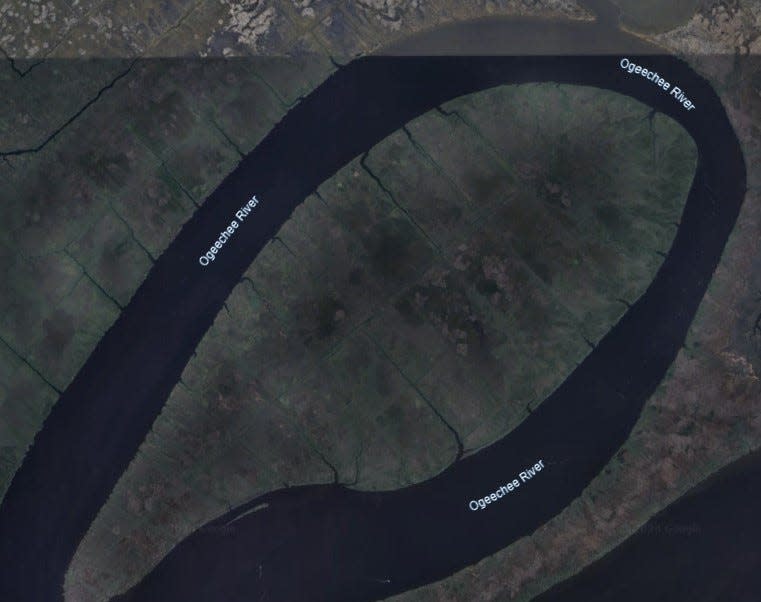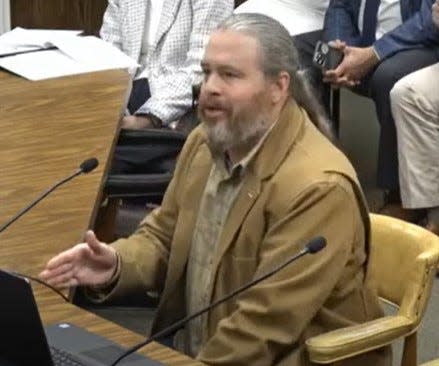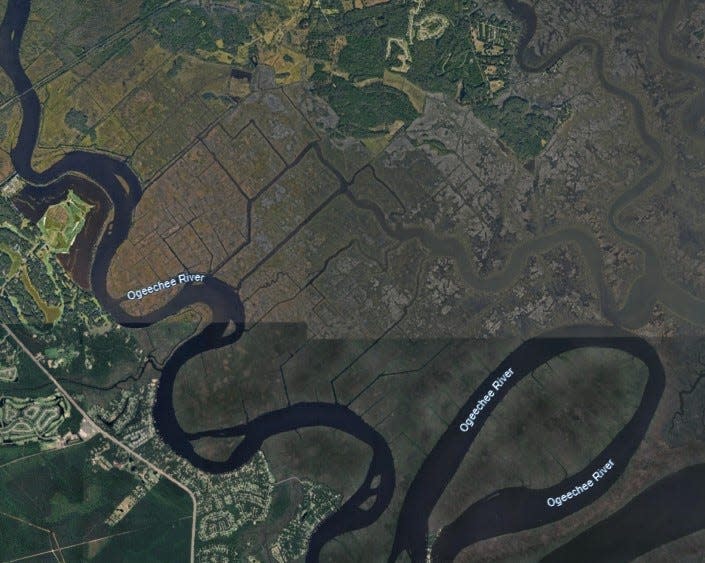Motivation for 'restoring' Georgia's former rice plantations drives debate over marsh ownership

Would it be a boon for conservation in coastal Georgia? Or is legislation aiming to streamline the process for proving ownership of tidal marsh really just a solution in search of a problem?
Supporters say Georgia House Bill 370 would encourage “restoration” for tens of thousands of acres scarred by straight-line canals carved into marshland by slaves centuries ago to manage water flow on the state’s string of rice plantations.
From an environmental standpoint, opponents counter that nature has spent hundreds of years adapting to those alterations and that reversing the process now could needlessly threaten the unique habitats that have evolved there.
Furthermore, the idyllic image being floated by the bill’s backers of pastoral tidal creeks once again meandering through what are now grid-like freshwater impounds is not just impractical but could do more harm than good – if those conditions could be re-created at all, experts say.
An issue steeped in history
Under the 1970 Georgia Coastal Marshlands Protection Act, the state owns the nearly 400,000 acres of wetlands lining its 100-mile coast. However, about 10% of that total is subject to land grants tied to Georgia’s Colonial planter class.
Those allowances – from the King of England until 1776 and then Georgia’s governors after the American Colonies declared their independence – enabled the establishment of rice plantations that, on the backs of thousands of enslave people, became a key cog in the state’s agriculture-driven economy.
In some cases, the original grant documents still exist. If their holders are able to prove an uninterrupted paper trail between themselves and the original recipients, they can claim ownership of the marsh.
However, to gain clear title, petitioners must navigate an exhaustive, expensive process through the state attorney general’s office. The review often takes years, and there’s no guarantee it will end in success.
HB 370 would shift responsibility for vetting claims to the State Properties Commission, which would have nine months (up from the six months originally proposed) to make a determination.
Those who successfully prove ownership – or are granted control by default if the state makes no determination during the allotted review period – would be permitted to alter the otherwise protected marsh, but for “conservation purposes” only.
Port's impact: Warehouse boom threatens coastal Georgia communities, environmental groups say
'I sat down and wrote the bill'
Jerry Williams, a Savannah physician, entrepreneur and self-professed conservationist, is among HB 370’s most-vocal supporters.
Williams has tried unsuccessfully for years to secure clear title to what is known as Arnold’s Point, a 1,000-acre tract of former rice fields encircled by a loop of the Ogeechee River in Bryan County, near the Chatham County line.
He insists he has proven a direct line to a grant issued in 1834 by Gov. Wilson Lumpkin.
“But they've taken the spaghetti approach,” Williams said, referring to the attorney general’s office. “They throw everything at the wall to try to muddy the waters, excuse the pun, and then to make it cost prohibitive for the private landowner to defend their title.”
A spokeswoman declined to comment on specific cases but said the attorney general’s office is currently involved with a grant petition in Bryan County and another in Glynn County.
HB 370 defines "conservation purposes” as any effort to “remediate, restore, or enhance natural conditions of coastal marshlands to substantially the same condition of such marshlands prior to manmade alteration or damage.”

Williams said that description is a perfect reflection of his vision for Arnold’s Point.
That’s largely because he drafted a predecessor bill that eventually became HB 370.
When asked in a phone interview about his role in the legislation, Williams initially suggested he had presented an “outline” of potential changes to state law regarding crown and governors’ grants to former state Sen. William Ligon and Rep. Jesse Petrea, Republicans representing coastal districts.
“There have been dozens and dozens and dozens of lawyers and representatives and environmental consultants and all kinds of people that have been involved in helping craft this piece of legislation,” he said.
When reminded that he told members of the House Judiciary Committee in January that he had written the original bill, Williams conceded that he’d offered more than just an outline.
“Yeah, I sat down and wrote the bill,” he said. “And then I took it to Senator Ligon and we took it to Representative Petrea, and then Representative Petrea got legislative counsel, you know, to work with us on it, okay? So yeah, that’s absolutely the truth” that he drafted the original language.
'It isn't natural'
In satellite images, Georgia’s former rice plantations stand out like misplaced puzzle pieces with their grid-like systems of ditches and canals abutting areas of undulating tidal channels.
"There’s nothing normal about that,” Williams said of the former rice fields. “Mother Nature doesn’t flow in straight lines.”
Unimpeded by curves, the volume and intensity of water flow increases, causing eroded sand to deposit into the Ogeechee and alter the river's navigation channel, he added.
“Mother Nature hasn’t healed itself,” Williams said. “What needs to happen 200 years later is adding back serpentine (creeks) and restoring the structure.”
Primary sponsors of HB 370, including Petrea from Savannah, also have wistfully expressed hope that the measure could turn back time.
“You can imagine the marsh (with creeks) that meander everywhere,” Petrea said during a recent discussion of the bill in the House Judiciary Committee. “And now you've got vast tracks that literally look like perpendicular lines. And it isn't natural.”
Williams insists visions of traditional creeks once again winding through former rice fields aren't far fetched. As proof, he points to two-decade-old research involving former rice plantations near Arnold’s Point.
In a 2004 thesis for her master’s degree at the University of Georgia, Alyson Craig observed former rice fields along the Ogeechee, including one where the Georgia Department of Transportation had done restoration in the late 1990s as “mitigation” for wetlands lost in an earlier road project.
Craig, now director of planning, design and development for the City of Charlotte in North Carolina, observed “dramatic signs of improvement” in the five years after the project.
To Williams, who noted that he finds it “offensive” when environmentalists question his motives, those findings illustrate HB 370’s potential to make the Georgia coast better by undoing what humans have wrought.
“That’s evidence that everything I’m talking about can be done successfully if it’s done right,” he insisted.
Or is it?
'A very long time to really change that'
Craig did not respond to requests for comment but, according to her lead adviser on the project, University of Georgia marine science professor Merryl Alber, the research did not address what Williams and other backers of HB 370 insist is at the heart of the measure.
The “restoration” of former rice fields cited in Craig's 67-page thesis essentially involved allowing saltwater to return, not physically altering the marsh to re-create traditional tidal creeks.
That's typically the scope of such projects, said Cheri Pritchard, spokesperson for the U.S. Army Corps of Engineers Savannah District.
"Generally, the tidal influence in old rice plantation fields was usually cut off by dikes and flow control structures," Pritchard explained in email. "Therefore, restoring the area to tidal flow/tidal marsh usually only involves breaching the dikes/structures in the least environmentally harmful way possible."
That was the case for the subjects of Craig's research, which concluded that the reintroduction of saltwater reshaped the mix of organisms and plants but "little to no change in the actual hard edges of canals,” added Alber, director of UGA’s Marine Institute
Even a former rice field where saltwater had been reintroduced a century earlier remained largely the same structurally.
“One of the things (Craig) concluded is that it would take a very long time to really change that,” Alber said. “So, in other words, unless you go in with engineering, I don't know how you get into a traditional winding creek.”
While stressing that she couldn't comment on potential projects, Pritchard noted that USACE permits for work within tidal marsh are "much less common" than those for other wetland types.
"They are usually complicated, given considerable attention and are very situationally dependent," she said. However, "internal changes needed for the area to return to healthy tidal marsh would be minimal."
Expediting expansion: GPA looks to pay for faster federal review of Savannah River terminal project
Climate change raises stakes
Rising seas fed by climate change and booming coastal development are accelerating saltwater intrusion into freshwater wetlands, a critical but shrinking habitat for wildlife such as migratory birds and waterfowl.
That makes areas like the former rice plantations increasingly rare.
Expansion of the Port of Savannah, particularly dredging to deepen the harbor to accommodate larger ships, also is a major factor.
“As the channel gets deeper, the denser saltwater is able to penetrate farther upriver,” explained Brynn Garner, spokesperson for the U.S. Fish and Wildlife Service Southeast Region. “The saltwater mixes with the freshwater, creating saltier conditions that change the character of the freshwater marsh.”
Freshwater marshes in the Savannah River Estuary once totaled 12,000 acres but now make up less than 5,000 acres, according to the U.S. Army Corps of Engineers.
That’s why federal officials were committed to restoring about 3,000 acres of freshwater wetlands at the Savannah National Wildlife Refuge that were overrun by saltwater in 2017 as the remnants of Hurricane Irma moved across the Georgia-South Carolina border.
The storm inflicted an estimated $18 million in damage at the refuge when its system of canals and earthen barriers, meant to keep saltwater out and freshwater in, was severely compromised. As a result, the structures were unable to effectively control water flow in 70% of the 3,000-acre impoundment area, leading to a widespread loss of freshwater vegetation that serves as valuable habitat.
More than six years later, those areas have not only been restored, but improvements have buttressed the refuge against climate-induced sea-level rise and extreme weather.

Banking on marsh ownership
Environmental issues aside, critics contend that money, not conservation, is the true driver of HB 370.
“We have not yet seen a compelling case for the actual need to ‘restore’ these functioning wetlands, beyond the desire to do so for mitigation banking purposes,” said Courtney Reich, coastal director at the Georgia Conservancy.
For more than 30 years, Georgia’s mitigation system has allowed entities such as the Georgia Ports Authority to “offset” the destruction of wetlands during development by paying for conservation efforts elsewhere.
Williams, Petrea and others say the former rice plantations could be eligible for mitigation banking because, under HB 370, grant holders who prove ownership could alter marshlands "to remediate, restore, or enhance natural conditions of coastal marshlands to substantially the same condition of such marshlands prior to manmade alteration or damage.”
But truly reversing those conditions by replacing straight waterways with traditional winding creeks could be just as destructive as alterations centuries ago that created the rice plantations.
“I’m not even sure it would be possible,” added Adler.
Even less ambitious efforts like re-introducing saltwater could be counterproductive for marshes that have adapted in the centuries since they were disturbed, Reich noted.
"In these cases, ‘restoration’ to some previous condition may adversely impact these transitional habitats,” she said. “Because these disturbances were so long ago and nature has adjusted to current conditions, it is unclear if there is a net ecological gain to be realized by returning these habitats to some original state for which we have no actual documentation.”
John Deem covers climate change and the environment on the Georgia coast. He can be reached at jdeem@gannett.com
This article originally appeared on Savannah Morning News: Bill sparks clash over future of historic Georgia rice plantations

